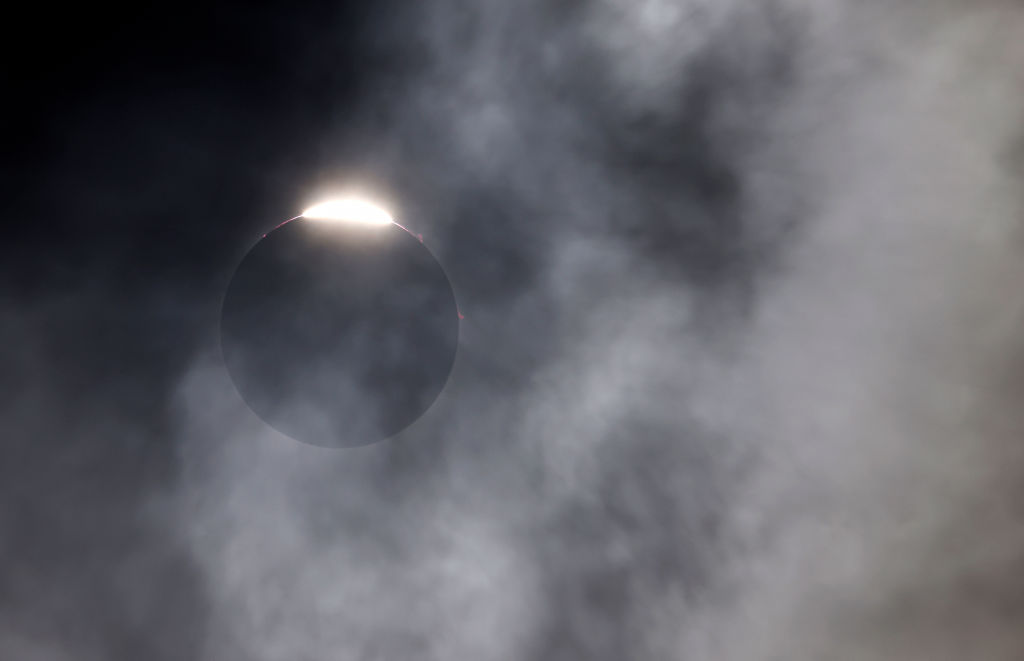Rare celestial spectacle blacks out Mexico, US, Canada

Source: X/Space Latest
Tens of millions of people have been awed by a rare celestial spectacle that swept over Mexico, the US and Canada on Tuesday morning (AEST).
The total solar eclipse turned daytime into night as the moon passed between the sun and Earth — blocking the sun’s light.
The “magical” and “stunning” event lasted a full four minutes, darkening the sky and bringing out the stars.
The wonder began in the Cook Islands, passed over Mexico and was seen over 13 US states before finishing in Canada.
Some 32 million people in the US were in the path of the total eclipse, and in many locations the weather provided picture-perfect viewing.
It was the first solar eclipse over North America since 2017, but the first such event in 800 years in cities like Indianapolis, according to NASA.
Skywatchers saw the moon appearing as a dark orb creeping in front of the sun, briefly blocking out all but a brilliant halo of light, or corona, around the sun’s outer edge.
Tweet from @NASA
The Mexican beachside resort town of Mazatlan was the first major viewing spot along the “path of totality” in North America.
Thousands of people gathered along the coastal promenade, setting themselves up in deck chairs with solar-safe eyewear as an orchestra played the Star Wars movie theme.
The crowds burst into cheers and applause and the eclipse reached totality.
Where there were clear skies, observers along the direct path of the eclipse were treated to the rare spectacle of the moon appearing as a dark orb creeping in front of the sun, briefly blocking out all but a brilliant halo of light, or corona, around, the sun’s outer edge.
A partial eclipse, in which the moon obscures a portion of the sun, unfolded across most of the continental US.
Tweet from @TheInsiderPaper
Eclipse fans gathered in numerous places along the “path of totality,” which stretched from Mexico’s Pacific Coast through Texas and across 14 other US states into Canada.
At up to four minutes and 28 seconds, the total eclipse of 2024 surpassed the duration of the one that traversed the US from coast to coast in 2017.
That one clocked in at up to two minutes and 42 seconds. According to NASA, total eclipses can last anywhere from 10 seconds to about 7½ minutes.
Some other cities along the path of totality included: San Antonio, Austin and Dallas, Texas; Indianapolis, Indiana; Cleveland, Ohio; Erie, Pennsylvania; Niagara Falls, New York, and Niagara Falls, Ontario, site of the famed waterfall, and Montreal, Quebec.
About 32 million people in the US live within the path of totality, with federal officials predicting another five million people will have travelled to be there.

The diamond ring effect is seen as the moon eclipses the sun. Photo: Getty
Countless eclipse-watching events were convened at bars, stadiums, fairgrounds and parks along the path of totality.
In upstate New York, at the Frontier Town campground in North Hudson, children ran around wearing eclipse T-shirts, while parents set up tables, chairs and beer coolers.
Connecticut residents Bob and Teresa Love were stretched out in the cargo bed of their ute, eating pastries and hoping the forecasted clouds hold off long enough to not obscure the spectacle.
“I’m trying not to get too excited because of weather, just trying to keep expectations real,” said Teresa, 49.
“Some people say it’s life-changing. I don’t know if it’s going to be life-changing, but I think it’s going to be cool to see.”
-with AAP








